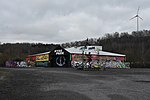Pye (Osnabrück district)

Pye is a district of the city of Osnabrück, Germany. Its positioning in the countryside on the outskirts of Osnabrück and its good transport connections to the city make it an appealing area for residents. Until 1972 Pye was a separate village in the district of Osnabrück. It belonged to the parish of St. Johann (St. John) in Osnabrück and was a predominantly Catholic area. Agriculture formed the backbone of the local economy. On 1 July 1972 it became a district of Osnabrück; since 1978 it has had its own parish (St. Matthias). Pye is also the location of the Piesberg (derived from "Pyes Berg" (Pye's Mountain)). Coal mining took place here during the 19th and 20th centuries. Even today, stones continue to be mined from the Piesberg quarry. The Piesberg was also the location of the largest landfill site in the Osnabrück region until June 2006. The Museum Industriekultur (Museum of Industrial Culture) is situated on the Piesberg, giving insight into the history of mining on the mountain. In Pye there is a street called "Am Pyer Ding". This is in reference to the Old German term "Thing" - meaning that Pye was also the location of such a "Thing". The countryside surrounding Pye is mostly characterised by small to medium-sized woods, grassland and a branch canal, which is an offshoot of the Mittelland Canal. The Osnabrück-Piesberg railway station is located at the edge of the district - currently it is only used for special train journeys (using steam locomotives) on event days, travelling there from the central station in Osnabrück via the Osnabrück-Altstadt station.
Excerpt from the Wikipedia article Pye (Osnabrück district) (License: CC BY-SA 3.0, Authors, Images).Pye (Osnabrück district)
Obere Waldstraße, Osnabrück Pye
Geographical coordinates (GPS) Address Nearby Places Show on map
Geographical coordinates (GPS)
| Latitude | Longitude |
|---|---|
| N 52.3222 ° | E 7.9972 ° |
Address
St. Matthias
Obere Waldstraße
49090 Osnabrück, Pye
Lower Saxony, Germany
Open on Google Maps








